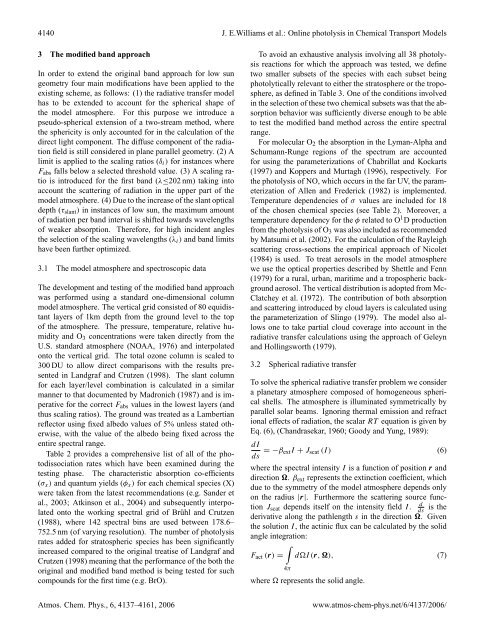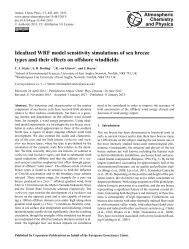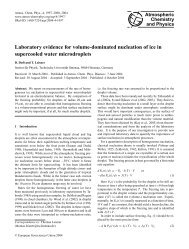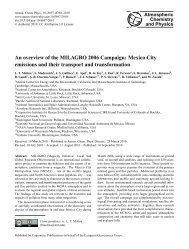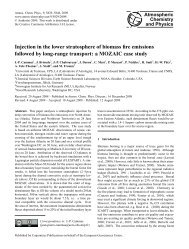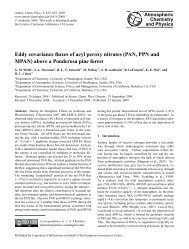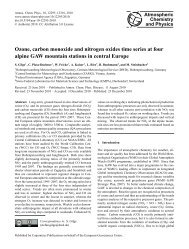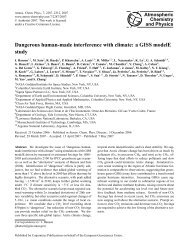A modified band approach for the accurate calculation of online ...
A modified band approach for the accurate calculation of online ...
A modified band approach for the accurate calculation of online ...
Create successful ePaper yourself
Turn your PDF publications into a flip-book with our unique Google optimized e-Paper software.
4140 J. E.Williams et al.: Online photolysis in Chemical Transport Models<br />
3 The <strong>modified</strong> <strong>band</strong> <strong>approach</strong><br />
In order to extend <strong>the</strong> original <strong>band</strong> <strong>approach</strong> <strong>for</strong> low sun<br />
geometry four main modifications have been applied to <strong>the</strong><br />
existing scheme, as follows: (1) <strong>the</strong> radiative transfer model<br />
has to be extended to account <strong>for</strong> <strong>the</strong> spherical shape <strong>of</strong><br />
<strong>the</strong> model atmosphere. For this purpose we introduce a<br />
pseudo-spherical extension <strong>of</strong> a two-stream method, where<br />
<strong>the</strong> sphericity is only accounted <strong>for</strong> in <strong>the</strong> <strong>calculation</strong> <strong>of</strong> <strong>the</strong><br />
direct light component. The diffuse component <strong>of</strong> <strong>the</strong> radiation<br />
field is still considered in plane parallel geometry. (2) A<br />
limit is applied to <strong>the</strong> scaling ratios (δi) <strong>for</strong> instances where<br />
Fabs falls below a selected threshold value. (3) A scaling ratio<br />
is introduced <strong>for</strong> <strong>the</strong> first <strong>band</strong> (λ≤202 nm) taking into<br />
account <strong>the</strong> scattering <strong>of</strong> radiation in <strong>the</strong> upper part <strong>of</strong> <strong>the</strong><br />
model atmosphere. (4) Due to <strong>the</strong> increase <strong>of</strong> <strong>the</strong> slant optical<br />
depth (τslant) in instances <strong>of</strong> low sun, <strong>the</strong> maximum amount<br />
<strong>of</strong> radiation per <strong>band</strong> interval is shifted towards wavelengths<br />
<strong>of</strong> weaker absorption. There<strong>for</strong>e, <strong>for</strong> high incident angles<br />
<strong>the</strong> selection <strong>of</strong> <strong>the</strong> scaling wavelengths (λi) and <strong>band</strong> limits<br />
have been fur<strong>the</strong>r optimized.<br />
3.1 The model atmosphere and spectroscopic data<br />
The development and testing <strong>of</strong> <strong>the</strong> <strong>modified</strong> <strong>band</strong> <strong>approach</strong><br />
was per<strong>for</strong>med using a standard one-dimensional column<br />
model atmosphere. The vertical grid consisted <strong>of</strong> 80 equidistant<br />
layers <strong>of</strong> 1km depth from <strong>the</strong> ground level to <strong>the</strong> top<br />
<strong>of</strong> <strong>the</strong> atmosphere. The pressure, temperature, relative humidity<br />
and O3 concentrations were taken directly from <strong>the</strong><br />
U.S. standard atmosphere (NOAA, 1976) and interpolated<br />
onto <strong>the</strong> vertical grid. The total ozone column is scaled to<br />
300 DU to allow direct comparisons with <strong>the</strong> results presented<br />
in Landgraf and Crutzen (1998). The slant column<br />
<strong>for</strong> each layer/level combination is calculated in a similar<br />
manner to that documented by Madronich (1987) and is imperative<br />
<strong>for</strong> <strong>the</strong> correct Fabs values in <strong>the</strong> lowest layers (and<br />
thus scaling ratios). The ground was treated as a Lambertian<br />
reflector using fixed albedo values <strong>of</strong> 5% unless stated o<strong>the</strong>rwise,<br />
with <strong>the</strong> value <strong>of</strong> <strong>the</strong> albedo being fixed across <strong>the</strong><br />
entire spectral range.<br />
Table 2 provides a comprehensive list <strong>of</strong> all <strong>of</strong> <strong>the</strong> photodissociation<br />
rates which have been examined during <strong>the</strong><br />
testing phase. The characteristic absorption co-efficients<br />
(σx) and quantum yields (φx) <strong>for</strong> each chemical species (X)<br />
were taken from <strong>the</strong> latest recommendations (e.g. Sander et<br />
al., 2003; Atkinson et al., 2004) and subsequently interpolated<br />
onto <strong>the</strong> working spectral grid <strong>of</strong> Brühl and Crutzen<br />
(1988), where 142 spectral bins are used between 178.6–<br />
752.5 nm (<strong>of</strong> varying resolution). The number <strong>of</strong> photolysis<br />
rates added <strong>for</strong> stratospheric species has been significantly<br />
increased compared to <strong>the</strong> original treatise <strong>of</strong> Landgraf and<br />
Crutzen (1998) meaning that <strong>the</strong> per<strong>for</strong>mance <strong>of</strong> <strong>the</strong> both <strong>the</strong><br />
original and <strong>modified</strong> <strong>band</strong> method is being tested <strong>for</strong> such<br />
compounds <strong>for</strong> <strong>the</strong> first time (e.g. BrO).<br />
To avoid an exhaustive analysis involving all 38 photolysis<br />
reactions <strong>for</strong> which <strong>the</strong> <strong>approach</strong> was tested, we define<br />
two smaller subsets <strong>of</strong> <strong>the</strong> species with each subset being<br />
photolytically relevant to ei<strong>the</strong>r <strong>the</strong> stratosphere or <strong>the</strong> troposphere,<br />
as defined in Table 3. One <strong>of</strong> <strong>the</strong> conditions involved<br />
in <strong>the</strong> selection <strong>of</strong> <strong>the</strong>se two chemical subsets was that <strong>the</strong> absorption<br />
behavior was sufficiently diverse enough to be able<br />
to test <strong>the</strong> <strong>modified</strong> <strong>band</strong> method across <strong>the</strong> entire spectral<br />
range.<br />
For molecular O2 <strong>the</strong> absorption in <strong>the</strong> Lyman-Alpha and<br />
Schumann-Runge regions <strong>of</strong> <strong>the</strong> spectrum are accounted<br />
<strong>for</strong> using <strong>the</strong> parameterizations <strong>of</strong> Chabrillat and Kockarts<br />
(1997) and Koppers and Murtagh (1996), respectively. For<br />
<strong>the</strong> photolysis <strong>of</strong> NO, which occurs in <strong>the</strong> far UV, <strong>the</strong> parameterization<br />
<strong>of</strong> Allen and Frederick (1982) is implemented.<br />
Temperature dependencies <strong>of</strong> σ values are included <strong>for</strong> 18<br />
<strong>of</strong> <strong>the</strong> chosen chemical species (see Table 2). Moreover, a<br />
temperature dependency <strong>for</strong> <strong>the</strong> φ related to O 1 D production<br />
from <strong>the</strong> photolysis <strong>of</strong> O3 was also included as recommended<br />
by Matsumi et al. (2002). For <strong>the</strong> <strong>calculation</strong> <strong>of</strong> <strong>the</strong> Rayleigh<br />
scattering cross-sections <strong>the</strong> empirical <strong>approach</strong> <strong>of</strong> Nicolet<br />
(1984) is used. To treat aerosols in <strong>the</strong> model atmosphere<br />
we use <strong>the</strong> optical properties described by Shettle and Fenn<br />
(1979) <strong>for</strong> a rural, urban, maritime and a tropospheric background<br />
aerosol. The vertical distribution is adopted from Mc-<br />
Clatchey et al. (1972). The contribution <strong>of</strong> both absorption<br />
and scattering introduced by cloud layers is calculated using<br />
<strong>the</strong> parameterization <strong>of</strong> Slingo (1979). The model also allows<br />
one to take partial cloud coverage into account in <strong>the</strong><br />
radiative transfer <strong>calculation</strong>s using <strong>the</strong> <strong>approach</strong> <strong>of</strong> Geleyn<br />
and Hollingsworth (1979).<br />
3.2 Spherical radiative transfer<br />
To solve <strong>the</strong> spherical radiative transfer problem we consider<br />
a planetary atmosphere composed <strong>of</strong> homogeneous spherical<br />
shells. The atmosphere is illuminated symmetrically by<br />
parallel solar beams. Ignoring <strong>the</strong>rmal emission and refract<br />
ional effects <strong>of</strong> radiation, <strong>the</strong> scalar RT equation is given by<br />
Eq. (6), (Chandrasekar, 1960; Goody and Yung, 1989):<br />
dI<br />
ds = −βextI + Jscat (I) (6)<br />
where <strong>the</strong> spectral intensity I is a function <strong>of</strong> position r and<br />
direction �. βext represents <strong>the</strong> extinction coefficient, which<br />
due to <strong>the</strong> symmetry <strong>of</strong> <strong>the</strong> model atmosphere depends only<br />
on <strong>the</strong> radius |r|. Fur<strong>the</strong>rmore <strong>the</strong> scattering source func-<br />
tion Jscat depends itself on <strong>the</strong> intensity field I.<br />
d<br />
ds<br />
is <strong>the</strong><br />
derivative along <strong>the</strong> pathlength s in <strong>the</strong> direction �. Given<br />
<strong>the</strong> solution I, <strong>the</strong> actinic flux can be calculated by <strong>the</strong> solid<br />
angle integration:<br />
�<br />
Fact (r) = d�I (r, �), (7)<br />
4π<br />
where � represents <strong>the</strong> solid angle.<br />
Atmos. Chem. Phys., 6, 4137–4161, 2006 www.atmos-chem-phys.net/6/4137/2006/


